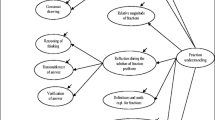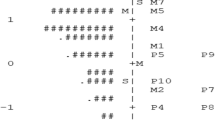Abstract
In this paper, we examine sixth grade students’ degree of conceptualization of fractions. A specially developed test aimed to measure students’ understanding of fractions along the three stages proposed by Sfard (1991) was administered to 321 sixth grade students. The Rasch model was applied to specify the reliability of the test across the sample and cluster analysis to locate groups by facility level. The analysis revealed six such levels. The characteristics of each level were specified according to Sfard’s framework and the results of the fraction test. Based on our findings, we draw implications for the learning and teaching of fractions and provide suggestions for future research.







Similar content being viewed by others
References
Adams, R., & Khoo, S. (1996). Quest: The interactive test analysis system. Victoria: ACER.
Arnon, I., Nesher, P., & Nirenburg, R. (1999). What can be learnt about fractions only with computers? In O. Zaslavsky (Ed.), Proceedings of the 23rd Conference of the International Group for the Psychology of Mathematics Education (Vol. 2, pp. 33–40). Haifa: PME.
Behr, M., Harel, G., Post, T., & Lesh, R. (1992). Rational number, ratio and proportion. In D. A. Grows (Ed.), Handbook on research on mathematics teaching and learning (pp. 296–333). New York: Macmillan.
Bond, T. G., & Fox, C. M. (2001). Applying the Rasch model: Fundamental measurement in the human sciences. Mahwah, NJ: Erlbaum.
Boulet, G. (1998). Didactical implications of children’s difficulties in learning the fraction concept. Focus on Learning Problems in Mathematics, 21(3), 48–66.
Byrnes, J. P., & Wasik, B. A. (1991). Role of conceptual knowledge in mathematical procedural learning. Developmental Psychology, 27, 777–786.
Charalambous, C., & Pitta-Pantazi, D. (2007). Drawing on a theoretical model to study students’ understandings of fraction. Educational Studies in Mathematics, 64, 293–316.
Charles, K., & Nason, R. (2001). Young children’s partitioning strategies. Educational Studies in Mathematics, 43, 191–221.
Christou, C., Papanastasiou, C., & Philippou, G. (2003). Studies ΙΕΑ: TIMSS-primary students’ results in mathematics. Nicosia: University of Cyprus.
Cottrill, J., Dubinsky, E., Nichols, D., Schwingendorf, K., Thomas, K., & Vidakovic, D. (1996). Understanding the limit concept: Beginning with a coordinated process scheme. The Journal of Mathematical Behavior, 15, 167–192.
Delaney, S., Charalambous, C., Hsu, H., & Mesa, V. (2007). The treatment of addition and subtraction of fractions in Cypriot, Irish, and Taiwanese textbooks. In J. H. Woo, H. C. Lew, K. S. Park, & D. Y. Seo (Eds.), Proceedings of the 31st Conference of the International Group for the Psychology of Mathematics Education (Vol. 2, pp. 193–200). Seoul: PME.
Dubinsky, E. (1991). Reflective abstraction in advanced mathematical thinking. In D. Tall (Ed.), Advanced mathematical thinking (pp. 95–126). Netherlands: Springer.
English, L., & Halford, G. (1995). Mathematics education. Models and processes. New Jersey: Erlbaum.
Goodson-Espy, T. (1998). The roles of reification and reflective abstraction in the development of abstract thought: Transitions from arithmetic to algebra. Educational Studies in Mathematics, 36, 219–245.
Gray, E., & Tall, D. (1994). Duality, ambiguity and flexibility: A proceptual view of simple arithmetic. Journal for Research in Mathematics Education, 26(2), 115–141.
Gray, E., & Tall, D. (2007). Abstraction as a natural process of mental compression. Mathematics Education Research Journal, 19(2), 23–40.
Hallett, D., Nunes, T., & Bryant, P. (2010). Individual differences in conceptual and procedural knowledge when learning fractions. Journal of Educational Psychology, 102(2), 395–406.
Hannula, M. S. (2003). Locating fraction on a number line. In N. A. Pateman, B. J. Dougherty, & J. T. Zilliox (Eds.), Proceedings of the 27th Conference of the International Group for the Psychology of Mathematics Education (Vol. 3, pp. 17–24). Honolulu: PME.
Herman, J., Ilucova, L., Kremsova, V., et al. (2004). Images of fractions as process and images of fractions in processes. In M. J. Hoines & A. B. Fuglestad (Eds.), Proceedings of the 28th Conference of the International Group of the Psychology of Mathematics Education (Vol. 4, pp. 249–256). Bergen: PME.
Hiebert, J., & Lefevre, P. (1986). Conceptual and procedural knowledge in mathematics: An introduction analysis. In J. Hiebert (Ed.), Conceptual and procedural knowledge: The case of mathematics (pp. 1–27). Hillsdale: Erlbaum.
Kamii, C., & Clark, F. (1995). Equivalent fractions: Their difficulty and educational implications. The Journal of Mathematical Behavior, 14(4), 365–378.
Kenney, P., & Silver, E. (1997). Results from the sixth mathematics assessment. Virginia: National Council of Teachers of Mathematics.
Kerslake, D. (1986). Fractions: Children’s strategies and errors. A report of the strategies and errors in secondary mathematics project. Windsor, England: NFER-Nelson.
Kieren, T. E. (1993). Rational and fractional numbers: From quotient fields to recursive understanding. In T. P. Carpenter, E. Fennema, & T. A. Romberg (Eds.), Rational numbers: An integration of research (pp. 49–84). New Jersey: Erlbaum.
Lamon, S. (1999). Teaching fractions and ratios for understanding. Essential content knowledge and instructional strategies for teachers. London: Erlbaum.
Marcoulides, G. A., & Drezner, Z. (1999). A procedure for detecting pattern clustering in measurement design. In M. Wilson & G. Engelhard Jr. (Eds.), Objective measurement: Theory into practice (Vol. 5, pp. 261–277). Ablex Publishing: Greenwich.
Ni, Y. (2001). Semantic domains of rational numbers and the acquisition of fraction equivalence. Contemporary Educational Psychology, 26, 400–417.
Noelting, G. (1983). The development of proportional reasoning and the ratio concept. Part.1—Differentation of stages. Educational Studies in Mathematics, 11, 217–253.
Nunes, T., et al. (2004). Vergnaud’s definition of concepts as a framework for research and teaching. Annual Meeting for the Association pour la Recherche sur le Développement des Compétences, Paris.
Pegg, J., & Tall, D. (2005). The fundamental cycle of concept construction underlying various theoretical frameworks. International Reviews on Mathematical Education, 37(6), 468–475.
Rittle-Johnson, B., Siegler, R. S., & Alibali, M. W. (2001). Developing conceptual understanding and procedural skill in mathematics: An iterative process. Journal of Educational Psychology, 93, 346–362.
Saxe, G. B., Taylor, E. V., MacIntosh, C., & Gearhart, M. (2005). Representing fractions with standard notation: A developmental analysis. Journal for Research in Mathematics Education, 36(2), 137–157.
Sfard, A. (1991). On the dual nature of mathematical conceptions: Reflections on processes and objects as different sides of the same coin. Educational Studies in Mathematics, 22, 1–36.
Wright, B., & Masters, G. (1981). The measurement of knowledge and attitude (Research memorandum no.30). Chicago: University of Chicago, Department of Education, Statistical Laboratory.
Acknowledgments
We wish to thank Dr. Leonidas Kyriakides and Dr. Demetra Pitta-Pantazi of the University of Cyprus for their constructive comments during the research of this study.
Author information
Authors and Affiliations
Corresponding author
Appendices
Appendix A
Fraction test items

Appendix B
The method applied for finding clusters
Suppose that I 1, I 2, I 3, … I n represent the items to be clustered into groups. First we find the range of the observed measurements that is (I max − I 2min). Next, we change the item values to a standardized 0–1 scale, using the formula \( {S_i} = \left( {{I_i} - {I_{{\min }}}} \right)/({I_{{\max }}} - {I_{{\min }}}) \), a transformation that conserves the relative item standing. We next sort the values S i in ascending order and calculate the gaps between two consecutive items, using the formula \( i\Delta = {S_{{i + 1}}} - {S_i} \) (where i = 1, 2, 3, … n). Finally, we sort the values of Δi in descending order (Δ1, Δ2, Δ3 …); the largest term Δ1 divides the items into two groups according to the largest gap identified among these items. The second largest term Δ2 further splits one of the two resulting groups into two subgroups based on the second largest gap, and so on. Hence, when the first k largest Δs are considered, the items are split into k + 1groups. The number of clusters that can be formed is determined by exploring the contribution of each iΔ to the cumulative Δ, which is expressed as a percentage and represents the explained variance.
Rights and permissions
About this article
Cite this article
Pantziara, M., Philippou, G. Levels of students’ “conception” of fractions. Educ Stud Math 79, 61–83 (2012). https://doi.org/10.1007/s10649-011-9338-x
Published:
Issue Date:
DOI: https://doi.org/10.1007/s10649-011-9338-x




